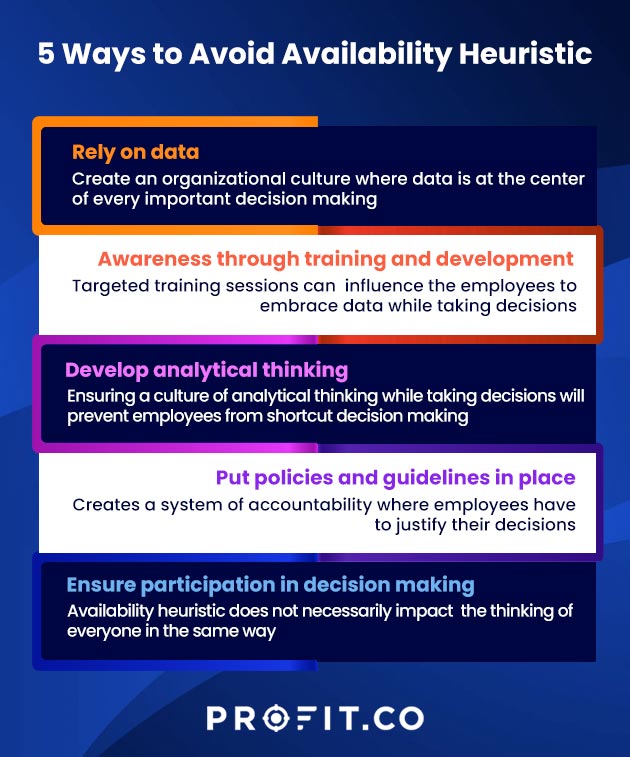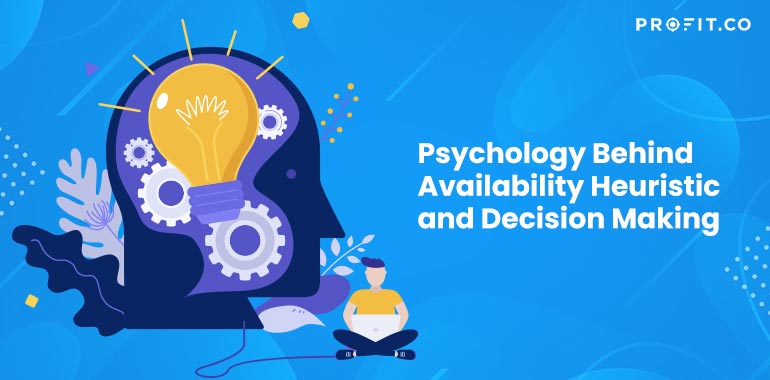In a fast moving world, business decisions need to be taken quickly and correctly on a consistent basis for long-term success of the organization. But decision making can get tricky when you have the constraint of time or you may lack complete information. In those times, you tend to rely on instincts and whatever available data to base your decisions. Such situations force you to take shortcuts in decision making. These shortcuts can test your decision making capabilities and can affect your judgment. During those times, your own personal biases come to play and influence your decisions, in the quest to take decisions quickly. These biases are called heuristics, and the availability heuristic is one of them.
What is the availability heuristic?
The availability heuristic is a type of cognitive bias that makes one take shortcuts to arrive at a decision based on the estimation of how likely something is to happen and how easily it comes to one’s mind, rather than basing the decision on facts, figures, information and logic.
Causes of availability heuristic
1. Previous experiences that left a strong impact on you
2. Things that happened in the recent past and still fresh in the memory
3. Information that get memorized easily
Characteristics of availability heuristic
When you exercise the cognitive bias of availability heuristic, you tend to:
1. Arrive at judgment based on the first piece of information that comes to mind.
2. Give more importance to the information you can remember and the information you received in the recent past.
3. Think about scenarios that are easily imaginable.
For instance, if you are preparing for an exam, the availability heuristic makes you subconsciously expect the questions that were asked in the previous exam, giving you a false perception. In this case, you are making an assumption based on the first piece of information that comes to your mind, as you would have recently reviewed the questions that were asked in the previous exam while preparing. Secondly, you are considering the more recent information, i.e., the questions asked in the previous exam, to be significant, though there is no reason to believe the same questions will be asked again. Thirdly, getting the same questions in the exam is an easily imaginable scenario and a shortcut to preparing for it.
Good and evil both increase at compound interest. That is why the little decisions you and I make every day are of such infinite importance.
Availability heuristic: The psychology behind it
Availability heuristic occurs mainly because we have the tendency to create mental shortcuts that help make decisions quickly. Following are some of the psychological phenomena behind the availability heuristic.
1. Frequency illusion (Baader–Meinhof phenomenon): Frequency illusion is the false belief that something you have learned about/known/seen that made a strong impression on you will happen more frequently. For instance, if you learn about a team member overachieving the monthly target a couple of times, you will associate that person with excellence and performance, even if the person does not achieve the same on a consistent basis.
2. The recency effect: The recency effect is the psychological phenomenon that makes you think that the information or perception that you acquired recently is more important than it actually is. This happens because of the human tendency to pay special attention and reinforce a newly acquired perception. This is the phenomenon that drives the human mind into placing sporting bets based on the recent successes of a team or the players without considering any other factors.
3. The primacy effect: The primacy effect is a cognitive bias that makes you believe that the information that you receive first is always better, even if it is not the case. It makes an individual make judgments based on the first impression. For instance, if you release a software product with some bugs, the initial reviews and impressions it creates among the users stay for a long time even if you release patches to address the issues, and even if your product is excellent. This is mainly because of the poor first impression the product made on the tech community and customers.
Availability of heuristic examples from the workplace
Judging employees for mistakes: One of the frequent instances of availability heuristic is making an employee who previously got into trouble as the usual suspect for other mishaps as well, without thoroughly examining the root cause of the problem. One arrives at this judgment by deducing that the person who made the mistake most recently would tend to make mistakes again.
Scapegoating employees in reviews: While doing a performance review or while looking for causes of team failures during a review, employees could have this bias based on how a particular employee had previously failed to achieve his/her goals and targets during the previous review period, or let down the team leading to problems in the recent past. This can lead to scapegoating and can cause employee dissatisfaction and employee turnover. This is the reason why there is a strong emphasis on being objective while doing an employee performance review.
Promoting people based on perception: The availability of heuristics can have an impact on promotions in the organization. When the candidates considered for promotion are reviewed based on achievements and failures from recent memory rather than the overall performance over a long period of time, or if they are judged based on the first impression they created and not based on their work on a continuous basis, or if they were reviewed based on the assumption that one candidate will most likely achieve success more frequently than the other rather than assessing them based on the factual data, then there is a danger of selecting a less suitable person for a higher position.
Adopting strategies that may not work: The availability heuristic can happen in business decision-making when business leaders decide to blindly imitate the success formula and strategies of a competitor without analyzing whether they will be applicable to their own purposes. If the idea/strategy that they imitated itself is flawed in the first place, it can spell instant failure. Similar strategies across competing companies can also lead to a crowded marketplace without anyone offering value to the customer.
Choosing vendors with a relatively poor track record: When you procure something from suppliers for your product team, you might reject a good supplier whom you and your team had problems with recently, and select a supplier with a poor track record historically. This is because you may tend to place more emphasis on personal experience from the recent past than on the more reliable information from across the organization.

Why does the availability heuristic occur?
Availability heuristic does not necessarily happen because of a conscious effort to skip facts, but occurs involuntarily and one does not realize it, which makes it even more troublesome. We overestimate the factual accuracy of things that come to mind easily because:
1. When we want to take quick decisions, our cognitive mind tries to find shortcuts to help us make decisions on time.
2. While the availability heuristic can affect judgment, there is always a probability of getting it right by chance. While it cannot bring favorable outcomes all the time, when it brings good outcomes in a few instances by chance, it reinforces these mental shortcuts by making people falsely assume that those good outcomes were actually because of their instinct-based quick decision-making.
3. The easier it is to get some information the easier it is to make a decision. So your minds tend to sway towards the more easily available information.
4. Personal experience plays a great role in delivering easily available information. It is easier to relate something that happened to you rather than hearing it secondhand. So, you tend to rely on your personal experiences, especially the most recent ones to make your decision.
5. It is convenient to make judgments based on assumptions that you firmly believe to be true, instead of relentlessly looking for facts and additional information to support the decision.
Impact of availability heuristic on businesses
Availability heuristic can lead to poor decision-making and biased, inaccurate judgment. It can have far-reaching implications on various aspects of business health. Availability heuristic can lead to:
1. Poor financial decisions can lead to allocating resources to the wrong priorities.
2. Prioritizing things that are not really important, but are perceived by the employees to be detrimental to success and growth.
3. Continuing with the wrong priorities for a long time regardless of the outcomes: in a data driven organization, wrong priorities and faulty strategies can be identified by tracking various metrics; but if you discard data and make decisions based on assumptions and instinct, you are less likely to correct the mistakes on time.
4. Setting goals and targets based on your wrong priorities.
5. Outcomes that do not lead to the realization of organizational objectives.
6. Adopting poor strategies that are not suited for your business.
7. Making wrong estimates based on perceptions rather than data; for example, it is possible to get the pricing strategy wrong by referring to the previous instances of pricing without taking into account the current market conditions, the competition, inflation, etc.
8. Making risky investments that do not bring ROI, by making decisions based on instinct and being overconfident, instead of having complete information. For example, purchasing a business system that worked well in your previous organization may not offer the same benefits and ROI if the size of the business, the scale of operations, and the nature of the business are different and require a different solution.
9. Running the business without properly measuring success or performance; when business leaders start making decisions using mental shortcuts, it creates a precedent of ignoring data and facts. This can eventually filter down to all levels and derail the organization.
10. A poor organizational culture where facts are ignored and employees or self opinionated when it comes to taking key decisions.
5 ways to avoid availability heuristic
It is evident that the availability of heuristics can impair judgment and cause serious problems in organizations in multiple ways, starting from the individual level all the way up to the team level and the organization as a whole. One bad decision does not necessarily destabilize the organization, but when imbibed in the organization’s culture and then flows down top to bottom from the leadership level, the availability heuristic can affect most of the decisions and snowball into massive failures in the organization. So it is indispensable to address the factors that cause the availability heuristic. Following are some of the ways in which you can avoid it.
Always rely on data: Today, data is more important than ever for organizations. Businesses emphasize KPIs and metrics for measuring performance and success; data plays a key role in making business-critical decisions. Discarding data and making decisions based on instincts and false perceptions is inexcusable at this age. It is crucial to create an organizational culture where data is at the center of every important decision made at every level. It needs to start from the leadership; an alignment mechanism such as Objectives and Key Results (OKR) can help businesses align employees to the culture of data-driven decision making. Book a free demo with our team to learn more about how OKR software can optimize your organization’s performance!
Mainstream awareness about heuristics in training and development: While cognitive biases are deeply ingrained in the thought process of individuals and are hard to change, constantly discussing them in training sessions and employee development programs can slowly and steadily bring a change in how employees think and act in the organization. However, it should be accompanied by other initiatives and a follow-up process to bring about a change in how decisions are made across the organization. Including metrics, KPIs, data analytics and measurements in training sessions can also drive the employees to embrace data while taking decisions.
Develop analytical thinking: The first step towards eliminating cognitive biases such as the availability heuristic is avoiding taking shortcuts. Developing analytical thinking and use of rationalism and logic while taking decisions can help employees avoid shortcuts and naturally look for more information before taking any important decisions.
Put policies and guidelines in place on how to take key decisions: While creating awareness can help address cognitive biases to some extent, in order to create a constant emphasis on avoiding these biases, it is essential to put in place policies and guidelines in the organization regarding how to make decisions. For instance, you can implement a policy that dictates employees consult their superiors before allocating resources beyond a certain amount. This creates a system of accountability where employees have to justify their decisions and are answerable to their superiors.
Ensure participation in decision making: One of the best ways to fight cognitive biases is to ensure the participation of employees in decision making. This is mainly because participation makes sure that there is someone on the team to point out the flaws in a decision and make suitable suggestions based on data. While the availability heuristic can filter down to all levels of the organization, it does not necessarily impact the thinking of everyone in the same way. So ensuring participation in decision making increases the chance of avoiding availability heuristic in decision making.
Frequently asked questions
1. What is the availability heuristic?
The availability heuristic is a cognitive bias that makes one take decisions based on false perceptions from recent memory or based on how likely something is to happen and how easily it comes to one’s mind.
2. What is an example of an availability heuristic?
Placing sporting bets based on the recent successes of a team or the players without considering any other factors is an example of an availability heuristic.
Final Thoughts
Availability heuristic bias is definitely a threat to decision making especially in a business environment as it can lead to domino effects. OKRs can help avoid Decision Fatigue. At the center of OKRs are focus and alignment. While OKRs can certainly help you prioritize and focus, it’s important never to overwork employees to the point that they start to make bad choices, and that includes managers. The top-level management must understand that any individual need not be overwhelmed with decision-making just because he/she is naturally gifted. Learn How OKRs can improve your decision-making capacity. You can get started on Profit.co completely free today!

